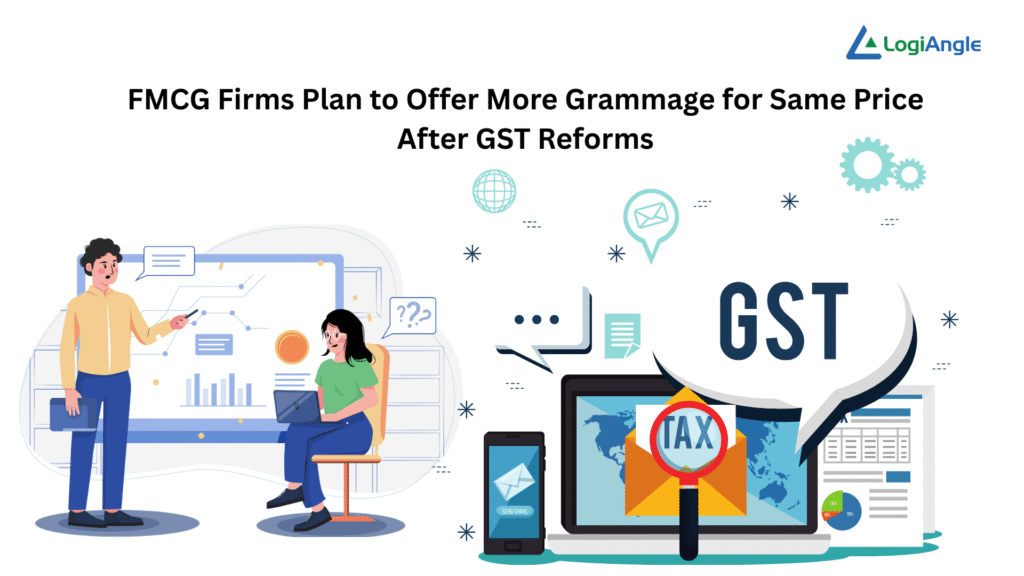
The recent GST reforms announced by Finance Minister Nirmala Sitharaman have stirred excitement across the fast-moving consumer goods (FMCG) sector. With tax rates reduced on a wide range of everyday essentials, FMCG firms plan to offer more grammage for the same price after GST reforms, ensuring that consumers directly benefit from the government’s decision. This move is expected to make daily-use items such as soaps, namkeen, chocolates, noodles, dairy products, and coffee more affordable, ultimately boosting demand and strengthening consumer sentiment.
Understanding the GST Reforms
As part of the revised tax structure, commonly used items such as soaps, toothbrushes, hair oil, namkeen, instant noodles, chocolates, and instant coffee will now attract a 5% GST, down from higher previous slabs. Even more impactful is the exemption on staples like Indian breads, paneer, and ultra-high temperature (UHT) processed milk, which will now carry zero tax.
Dairy products like ghee and ice cream have also seen a significant reduction, moving from 12% and 18% GST respectively to just 5%. For millions of Indian households, this translates to direct savings on everyday purchases.
Why Grammage Matters in FMCG
In India’s price-sensitive market, especially for ₹5 and ₹10 packs, companies find it difficult to reduce prices further without disrupting their pricing architecture. Instead, increasing grammage (the quantity of product in a pack) allows Fast-moving consumer goods firms to pass on the benefit of lower taxes without altering retail price points.
For example, a ₹10 packet of namkeen that previously contained 22 grams might now contain 25 grams, giving the consumer more value for the same price. This not only improves affordability but also enhances brand trust, particularly in rural and semi-urban areas where consumers are highly conscious of value per rupee spent.
How FMCG Companies Are Responding
1. Ethnic Snacks & Packaged Foods
Executives at major food brands such as Bikaji Foods International have already confirmed plans to expand grammage in smaller packs priced at ₹5 and ₹10. Ethnic snacks like bhujia, namkeens, and mixtures are now taxed at 5%, down from 12%. Companies believe this reduction will allow them to attract more consumers and drive higher sales volumes during the festive season.
2. Coffee & Beverages
The coffee segment, too, is gearing up to pass on savings. Instant coffee, coffee extracts, and concentrates have been moved to the 5% slab. Brands such as CCL Products (Continental Coffee) have announced a strategy that combines price drops, promotional offers, and increased grammage per pack. This multipronged approach ensures affordability while stimulating consumption in both urban and rural markets.
3. Dairy Sector Adjustments
The dairy industry is one of the biggest beneficiaries of the reforms. Products like ghee, butter, and ice cream will now attract only 5% GST, while staples like paneer and UHT milk are fully exempt. Companies such as Mother Dairy and Amul have already committed to passing on these benefits. Amul, in particular, plans a wide-scale reduction across its portfolio, ensuring more households can afford branded dairy products.
4. Personal Care & Household Products
Personal care companies, including Joy Personal Care (RSH Global), see this as an opportunity to strengthen their connection with rural households. With soaps, oils, and toothbrushes now at 5% GST, these firms expect stronger rural demand, which has already been the primary growth driver for six straight quarters.
Impact on Rural and Urban Consumers
Rural India has consistently driven FMCG growth, thanks to smaller pack sizes that cater to mass affordability. The increase in grammage at fixed price points will particularly benefit rural families, where every rupee saved or gained in value matters.
At the same time, urban consumers stand to benefit from reduced prices on larger packs, especially in categories like dairy and chocolates. With disposable incomes stretched by inflation, these changes will free up household budgets, allowing families to spend more during the festive season.
Festive Season Tailwinds
The timing of these reforms is particularly significant. With festivals like Diwali, Durga Puja, and Dussehra around the corner, consumption is expected to rise sharply. FMCG firms are preparing promotional campaigns that highlight both increased grammage and lower prices, creating positive sentiment in the market.
By directly linking tax savings to consumer benefits, companies are not only complying with the spirit of GST reforms but also reinforcing trust at a time when shoppers are making more considered purchases.
Long-Term Industry Benefits
- Boost in Demand – Lower prices and higher value will push volume growth across categories.
- Shift to Branded Goods – Affordable prices will encourage consumers to move from unbranded or loose products to packaged, branded alternatives, improving quality and safety.
- Rural Market Penetration – With enhanced grammage, FMCG brands can deepen their presence in rural areas, which are expected to drive the next wave of growth.
- Higher Competitive Intensity – Companies will innovate around pack sizes, product offerings, and promotional campaigns, benefiting consumers with more choices and better value.
Conclusion
The GST reforms mark a turning point for India’s FMCG industry. By lowering tax rates on essentials, the government has opened the door for companies to offer more grammage for the same price or reduce prices in larger packs. From ethnic snacks and coffee to dairy and personal care, every segment of the FMCG sector is preparing strategies to ensure that consumers feel the benefit in their daily shopping baskets.
With rural demand strong and urban consumption recovering, the move could not have come at a better time. As the festive season approaches, these reforms are expected to lift consumer sentiment, increase purchasing power, and strengthen the bond between FMCG brands and Indian households.
